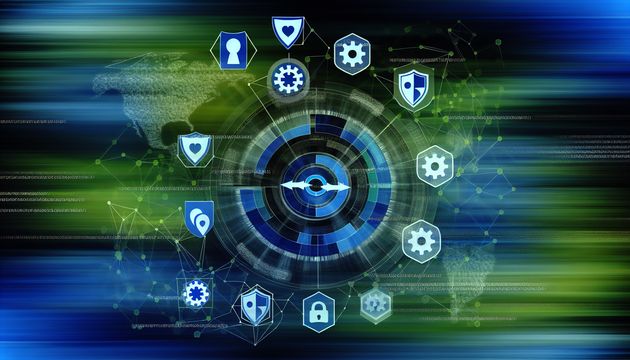
Strengthening Healthcare Cybersecurity Against Ransomware Threats
The healthcare sector is increasingly under siege from cybercriminals, with ransomware attacks posing a significant threat to operational integrity and patient safety. The recent attack on DaVita by the Interlock ransomware gang underscores the urgency for healthcare organizations to bolster their cybersecurity defenses. Unlike traditional data breaches that focus on data theft, ransomware attacks aim to disrupt operations by encrypting critical systems and demanding a ransom for decryption. This shift in tactics necessitates a reevaluation of cybersecurity strategies within the healthcare industry to effectively counter these evolving threats.
Implications for Healthcare Cybersecurity
Evolving Threat Landscape
The healthcare sector has become a prime target for ransomware attacks, as demonstrated by the recent incident involving DaVita. The Interlock ransomware gang claimed responsibility for the attack, highlighting the evolving threat landscape in healthcare cybersecurity. Unlike traditional data breaches, which primarily focus on data theft, ransomware attacks aim to disrupt operations by encrypting critical systems and demanding a ransom for decryption. This shift in tactics underscores the need for healthcare organizations to adapt their cybersecurity strategies to address these emerging threats effectively.
Impact on Patient Care and Safety
Ransomware attacks in the healthcare sector can have severe implications for patient care and safety. In the case of DaVita, the attack disrupted internal operations and encrypted certain on-premises systems, affecting the delivery of essential medical services (Comparitech). Although patient care at DaVita centers and patients’ homes continued, the incident highlights the potential for treatment delays and compromised patient safety in the event of a more severe attack. Healthcare providers must prioritize cybersecurity to ensure uninterrupted care delivery and protect patient safety.
Regulatory and Compliance Challenges
The DaVita ransomware attack also underscores the regulatory and compliance challenges faced by healthcare organizations in the wake of such incidents. Healthcare providers are subject to stringent regulations, such as the Health Insurance Portability and Accountability Act (HIPAA), which mandates the protection of patient data. Following the attack, DaVita disclosed the incident to the U.S. Securities and Exchange Commission (SEC), indicating the regulatory scrutiny that healthcare organizations face in the aftermath of cyberattacks (BleepingComputer). Compliance with these regulations requires healthcare providers to implement robust cybersecurity measures and promptly report breaches to relevant authorities.
Financial Implications
Ransomware attacks can have significant financial implications for healthcare organizations. The DaVita incident involved the theft of 1.5 terabytes of data, including sensitive patient records and financial details (BleepingComputer). The potential costs associated with such attacks include ransom payments, legal fees, regulatory fines, and the expenses related to restoring affected systems. Additionally, the reputational damage resulting from a data breach can lead to a loss of patient trust and a decline in revenue. Healthcare organizations must weigh these financial risks when developing their cybersecurity strategies.
Strategies for Enhancing Cybersecurity
To mitigate the risks associated with ransomware attacks, healthcare organizations must adopt comprehensive cybersecurity strategies. These strategies should include implementing multi-layered security measures, such as network segmentation (dividing a network into smaller parts to limit access), regular security audits, and employee training programs (CSIDB). By investing in these measures, healthcare providers can better protect patient data, maintain operational resilience, and minimize the impact of cyber threats. Additionally, organizations should develop robust incident response plans to ensure a swift and effective response to cyberattacks, minimizing disruption to patient care.
Importance of Collaboration and Information Sharing
Collaboration and information sharing among healthcare organizations, government agencies, and cybersecurity experts are crucial in combating ransomware attacks. By sharing threat intelligence and best practices, healthcare providers can enhance their cybersecurity defenses and stay ahead of emerging threats. Initiatives such as the Healthcare Information Sharing and Analysis Center (H-ISAC) facilitate this collaboration, enabling organizations to share information about cyber threats and vulnerabilities in a secure environment. By participating in such initiatives, healthcare providers can improve their ability to detect and respond to ransomware attacks.
Future Outlook
The DaVita ransomware attack serves as a stark reminder of the ongoing cybersecurity challenges facing the healthcare sector. As healthcare organizations continue to digitize patient records and rely on interconnected systems, the risk of cyberattacks will persist and evolve. To address these challenges, healthcare providers must remain vigilant, adapt to emerging threats, and prioritize cybersecurity to safeguard patient data and ensure uninterrupted care delivery. By investing in comprehensive cybersecurity strategies and fostering collaboration within the industry, healthcare organizations can enhance their resilience against ransomware attacks and protect the integrity of patient care.
Conclusion
In light of the DaVita ransomware incident, healthcare organizations must recognize the persistent cybersecurity challenges they face. As the sector continues to digitize and interconnect, the risk of cyberattacks will only grow. Vigilance, adaptability, and a strong focus on cybersecurity are essential to safeguarding patient data and ensuring uninterrupted care. By investing in robust cybersecurity strategies and fostering industry collaboration, healthcare providers can strengthen their defenses against ransomware attacks and maintain the integrity of patient care.
References
- BleepingComputer. (2025). Interlock ransomware claims DaVita attack, leaks stolen data. https://www.bleepingcomputer.com/news/security/interlock-ransomware-claims-davita-attack-leaks-stolen-data/
- Comparitech. (2025). Ransomware gang Interlock claims attack on kidney dialysis company DaVita, 1.5 TB of data stolen. https://www.comparitech.com/news/ransomware-gang-interlock-claims-attack-on-kidney-dialysis-company-davita-1-5-tb-of-data-stolen/
- CSIDB. (2025). Incident report on DaVita ransomware attack. https://www.csidb.net/csidb/incidents/4454944f-3574-4a6e-be46-ab37e0f39d49/



